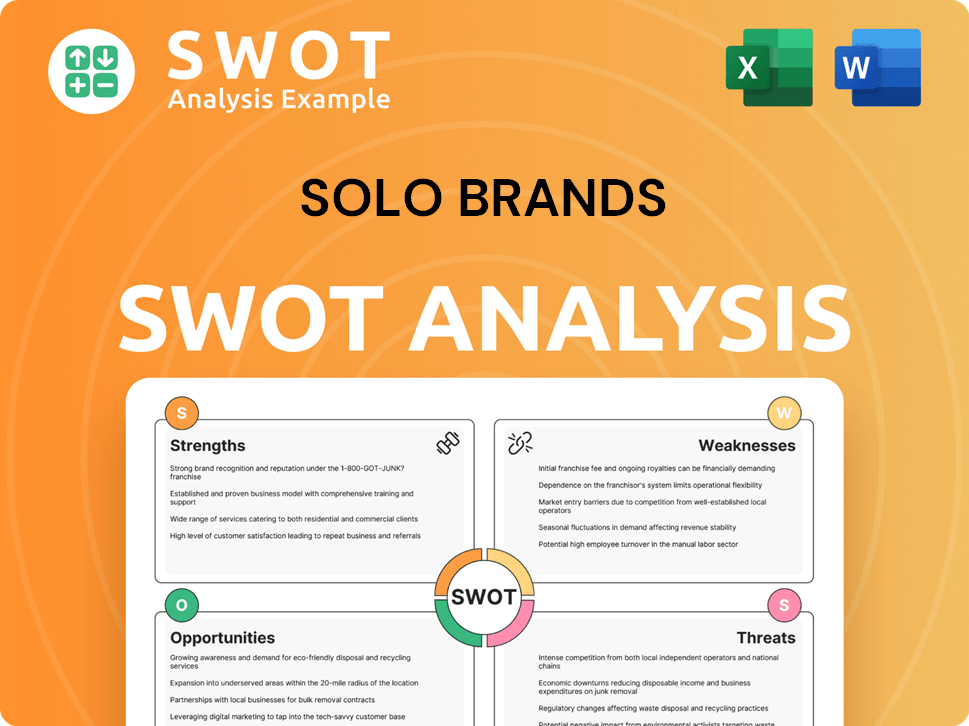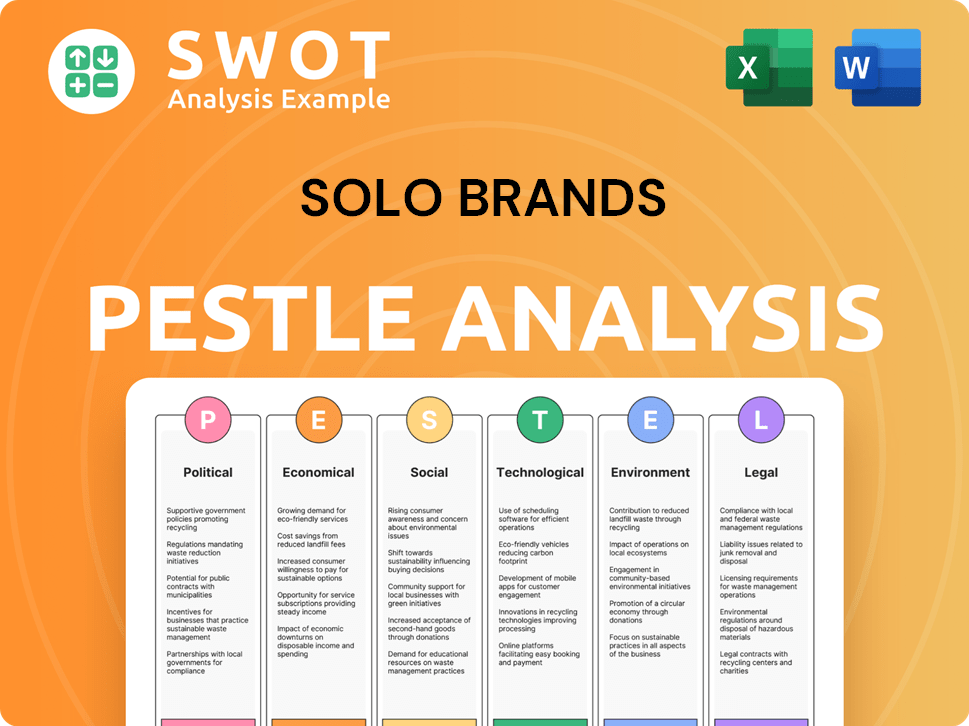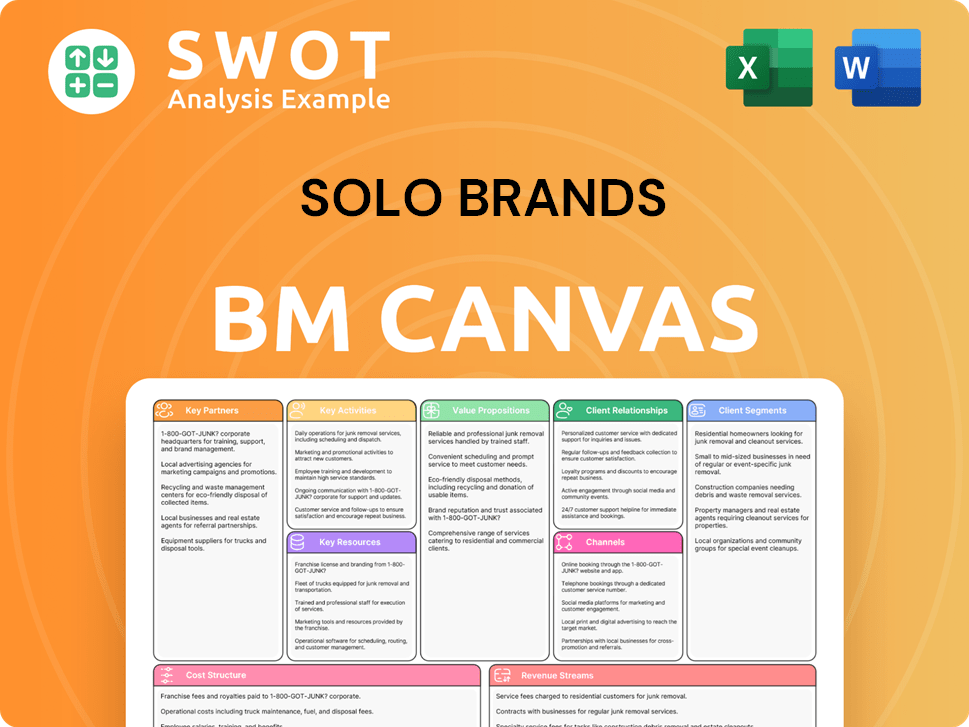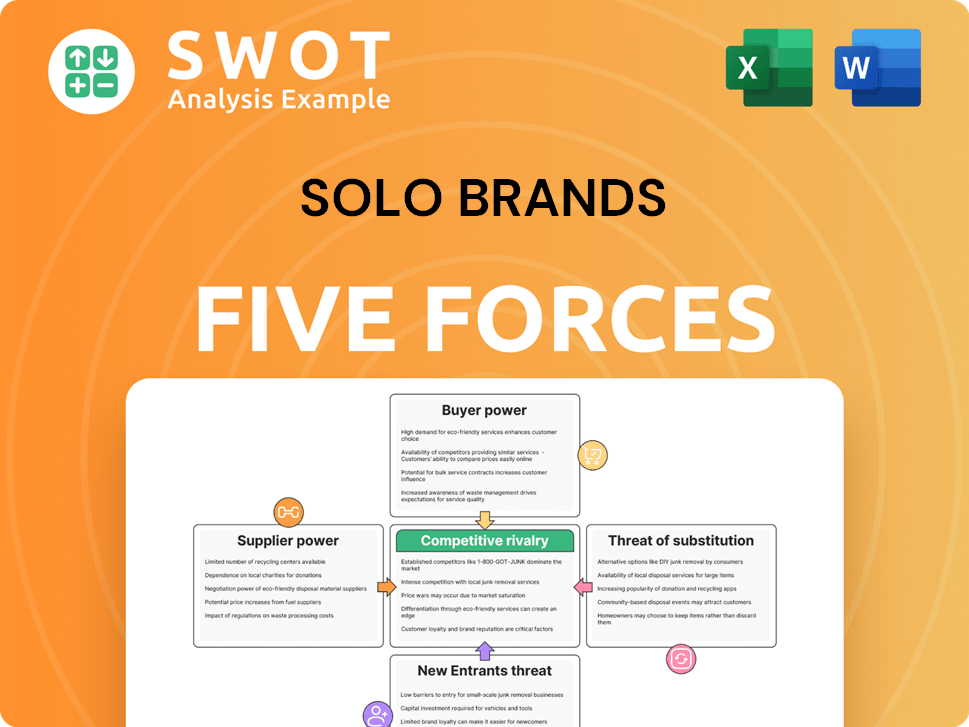Solo Brands Bundle
Can Solo Brands Rebound?
Solo Brands, the parent company behind popular outdoor lifestyle brands like Solo Stove, faces a critical juncture. Recent financial performance, including a 9.5% decline in Q1 2025 net sales, highlights the challenges the company confronts. This Solo Brands SWOT Analysis will explore the company's growth strategy and future prospects, offering a deep dive into its expansion initiatives and financial outlook.

This market analysis will evaluate Solo Brands' direct-to-consumer (DTC) strategy and analyze its brand portfolio, including Solo Stove, Chubbies, Oru Kayak, and ISLE Paddle Boards. Understanding the company's growth strategy is crucial for assessing its future prospects, considering factors such as market share and the competitive landscape. We'll also examine potential growth drivers and the impact of economic trends on Solo Brands' long-term growth strategy.
How Is Solo Brands Expanding Its Reach?
The Marketing Strategy of Solo Brands is centered on aggressive expansion initiatives designed to boost its growth strategy and diversify its revenue streams. These initiatives include expanding its product offerings, adjusting sales channels, and exploring international markets. The company's approach is data-driven, with a focus on aligning marketing investments directly with profit generation and building pricing strategies to optimize channel performance. These efforts are crucial for navigating the competitive landscape and achieving long-term growth.
In 2023, the company broadened its cooking category with the launch of the Pi Prime, a standalone stainless steel pizza oven, and introduced indoor fire products to allow for year-round use. For 2024, the company planned to launch five new products within the Solo Stove segment, including the Windchill 47 cooler. This product diversification is a key element of its strategy to attract a wider customer base and increase sales. The company is also focused on building pricing strategies to align channels.
Beyond product diversification, Solo Brands is adjusting its sales channels. While maintaining a digital-first strategy, with 70.2% of sales in 2024 coming from direct-to-consumer channels, the company also operates twelve Chubbies retail stores and one ISLE surf pro-shop, with plans for further retail expansion. This suggests a strategic move towards an omnichannel approach, aiming for a more balanced mix between DTC and wholesale, with a goal of reaching an 80/20 split over the next few years from the current 85/15.
The company is actively expanding its product lines. This includes launching new products within existing segments and entering new categories. In 2023, they introduced the Pi Prime pizza oven and indoor fire products. For 2024, new products like the Windchill 47 cooler were planned.
Solo Brands is strategically adjusting its sales channels. While maintaining a strong direct-to-consumer (DTC) presence, the company is also expanding its retail footprint. The goal is to balance DTC and wholesale channels, aiming for an 80/20 split in the future.
The company is exploring international expansion opportunities. With a growing presence in Europe, Canada, and Australia, Solo Brands is looking to tap into new markets. This strategic move aims to diversify revenue sources and increase global brand awareness.
The company is undergoing strategic realignments to optimize operations. This includes terminating underperforming marketing agreements and reorganizing reporting units. These actions are designed to eliminate costs and capitalize on potential synergies.
Solo Brands' growth strategy involves several key initiatives aimed at expanding its brand portfolio and market share. These initiatives are designed to drive revenue growth and enhance long-term value. The company is focused on a data-driven approach to ensure that marketing investments are directly tied to profit generation.
- Product Diversification: Launching new products to cater to a wider customer base.
- Channel Optimization: Balancing DTC and wholesale channels for a more robust sales mix.
- International Expansion: Growing its presence in key international markets.
- Strategic Realignment: Streamlining operations and eliminating costs to improve efficiency.
Solo Brands SWOT Analysis
- Complete SWOT Breakdown
- Fully Customizable
- Editable in Excel & Word
- Professional Formatting
- Investor-Ready Format

How Does Solo Brands Invest in Innovation?
The company focuses on innovation and technology to improve its products and operations, though specific details on R&D spending and technology adoption aren't widely available in recent reports. Their approach centers on creating 'ingenious products influenced by customer feedback' and consistently delivering 'high-quality products that are loved by our customers and revolutionize the outdoor experience'. This customer-focused strategy guides their product development.
The company uses a 'digitally-native platform,' mainly through e-commerce and brand-specific websites. Their digital distribution includes their corporate website, Amazon Marketplace, and other select e-commerce marketplaces. Digital marketing is a key area, with $12.4 million spent in 2023, representing 22% of total revenue, highlighting the importance of online presence for their growth strategy.
They use social media platforms like Instagram (98,000 followers) and TikTok (52,000 followers as of Q4 2023) to boost engagement. In March 2024, they appointed PMG as their media Agency of Record to improve marketing efficiency and increase demand. Efforts are also underway to improve marketing effectiveness under new interim leadership and build a product innovation culture. For more context, you can explore the Brief History of Solo Brands.
Product development at the company is guided by customer feedback. They aim to create innovative products that enhance the outdoor experience.
The company primarily operates through e-commerce channels. Their direct-to-consumer (DTC) strategy is a key element of their business model.
Digital marketing plays a significant role in their strategy. They use social media and other online platforms to reach customers.
They are working to improve marketing effectiveness. The appointment of PMG as the media Agency of Record is part of this effort.
The company is building a culture of product innovation. This involves new leadership and a focus on new product development.
They use social media to engage with customers. Platforms like Instagram and TikTok are used to build brand awareness.
The company's approach to technology and innovation is centered around enhancing product offerings and optimizing operations. Their focus is on a digitally-native platform, primarily through e-commerce channels and brand-specific websites. Digital marketing is a key component, with significant investments in social media and online advertising.
- E-commerce Platform: Focus on direct-to-consumer sales through their website and marketplaces.
- Digital Marketing: Significant investment in digital marketing to drive engagement and sales.
- Customer Feedback: Use of customer feedback to inform product development and innovation.
- Social Media: Leveraging platforms like Instagram and TikTok for brand building and customer interaction.
Solo Brands PESTLE Analysis
- Covers All 6 PESTLE Categories
- No Research Needed – Save Hours of Work
- Built by Experts, Trusted by Consultants
- Instant Download, Ready to Use
- 100% Editable, Fully Customizable

What Is Solo Brands’s Growth Forecast?
The financial outlook for Solo Brands presents significant challenges. The company experienced a decrease in net sales for the fiscal year 2024, along with a net loss. This downturn is primarily attributed to the Solo Stove segment's performance. The company's ability to navigate these financial difficulties and achieve sustainable growth will be crucial.
The company's financial health is under scrutiny. The company's reliance on cash generated from operations and its substantial debt burden highlight the need for effective strategies to improve financial performance. The company is actively working on measures to improve its financial position, including cost-cutting initiatives and debt refinancing.
The company's financial performance in the first quarter of 2025 shows a continuation of the negative trends observed in 2024. While the Chubbies segment showed strong growth, the overall financial picture remains challenging. The company is facing liquidity risks, and its long-term success depends on its ability to address these issues and implement a successful growth strategy.
Net sales for 2024 were $454.6 million, an 8.1% decrease compared to the previous year. The gross profit decreased by 13.9% to $260.3 million, with a gross margin of 57.3%. The company reported a GAAP net loss of $180.2 million.
Net sales in Q1 2025 were $77.3 million, a 9.5% decrease from Q1 2024. The gross profit was $42.6 million, or 55.2% of net sales. The net loss for Q1 2025 was $18.6 million, indicating continued financial pressure.
As of December 31, 2024, Solo Brands had a net loss of $113.4 million and an accumulated deficit of $228.8 million. The company has expressed substantial doubt about its ability to continue as a going concern due to these factors.
Cash and cash equivalents increased to $206.4 million as of March 31, 2025, primarily due to net drawdowns on the Revolving Credit Facility. Total outstanding debt as of Q1 2025 was $427.9 million, highlighting significant financial obligations.
To improve its financial position, Solo Brands is focusing on several key areas. These include cost reduction through a reduction in force and distribution center closures. The company is also actively evaluating strategies to refinance its existing debt, which may involve restructuring or issuing new debt.
- Debt Refinancing: Exploring options to restructure or issue new debt.
- Cost Reduction: Implementing measures to decrease operational expenses.
- Operational Improvements: Streamlining operations to enhance efficiency.
Chubbies Segment: The strong performance of the Chubbies segment offers a potential area for growth.
Solo Brands Business Model Canvas
- Complete 9-Block Business Model Canvas
- Effortlessly Communicate Your Business Strategy
- Investor-Ready BMC Format
- 100% Editable and Customizable
- Clear and Structured Layout

What Risks Could Slow Solo Brands’s Growth?
The path for Solo Brands is fraught with potential pitfalls, making its 'growth strategy' a complex endeavor. The company faces a multitude of challenges that could significantly hinder its ability to achieve its expansion goals. Understanding these risks is critical for anyone evaluating the 'future prospects' of the company.
A key concern revolves around the highly competitive nature of the market. The low barriers to entry and the ease with which competitors can replicate products create a constant pressure. Moreover, the company's inconsistent growth rates and the uncertainty surrounding its future performance add to the complexity of its situation.
Financially, Solo Brands is under pressure, raising substantial doubt about its ability to continue as a going concern. Recurring net losses and an accumulated deficit are major concerns. The company's reliance on cash from operations and the challenges in refinancing its existing debt of $427.9 million highlight the financial fragility.
The market is intensely competitive with low barriers to entry. Competitors can easily imitate products, putting pressure on Solo Brands. This environment makes it difficult to sustain growth and maintain market share.
The company's financial health is a significant concern. Recurring net losses and an accumulated deficit raise doubts about its ability to operate. Refinancing the $427.9 million debt is a major challenge.
Operational risks include the potential inability to realize the benefits of strategic plans. Material weaknesses in internal controls, identified as of December 31, 2024, also pose a threat to smooth operations. These weaknesses were also present in 2023.
Reliance on third-party manufacturers, primarily outside the U.S., creates supply chain vulnerabilities. Fluctuations in costs of raw materials and geopolitical conflicts can also disrupt operations. Trade tariffs continue to impact the supply chain and cost structure.
Emerging risks include AI-powered supply chain attacks and cloud infrastructure compromises. Regulatory and compliance risks, particularly those related to data privacy and security, could result in significant costs and liabilities in 2025.
In February 2025, Solo Brands received a delisting notice from the NYSE due to its stock price falling below $1 for 30 consecutive trading days. The company anticipates difficulties in remaining compliant with financial covenants due to its indebtedness and business uncertainty.
The company's ability to secure additional financing is crucial. Failure to do so, or to improve operations, could lead to bankruptcy. The company's indebtedness and business uncertainty make it hard to meet financial covenants.
The company may not fully realize expected benefits from its strategic plans or restructuring. Identified material weaknesses in internal controls over financial reporting, as of December 31, 2024, pose additional operational challenges. These weaknesses were also present in 2023.
Supply chain disruptions, including fluctuations in raw material costs, could impact manufacturing. Geopolitical conflicts and trade tariffs continue to be a concern. The company is reducing its reliance on China-sourced products.
Technological disruptions, such as AI-powered supply chain attacks, are emerging threats. Regulatory and compliance risks, particularly those related to data privacy and security, could result in significant costs and liabilities. For further analysis, you can explore the Target Market of Solo Brands.
Solo Brands Porter's Five Forces Analysis
- Covers All 5 Competitive Forces in Detail
- Structured for Consultants, Students, and Founders
- 100% Editable in Microsoft Word & Excel
- Instant Digital Download – Use Immediately
- Compatible with Mac & PC – Fully Unlocked

Related Blogs
- What are Mission Vision & Core Values of Solo Brands Company?
- What is Competitive Landscape of Solo Brands Company?
- How Does Solo Brands Company Work?
- What is Sales and Marketing Strategy of Solo Brands Company?
- What is Brief History of Solo Brands Company?
- Who Owns Solo Brands Company?
- What is Customer Demographics and Target Market of Solo Brands Company?
Disclaimer
All information, articles, and product details provided on this website are for general informational and educational purposes only. We do not claim any ownership over, nor do we intend to infringe upon, any trademarks, copyrights, logos, brand names, or other intellectual property mentioned or depicted on this site. Such intellectual property remains the property of its respective owners, and any references here are made solely for identification or informational purposes, without implying any affiliation, endorsement, or partnership.
We make no representations or warranties, express or implied, regarding the accuracy, completeness, or suitability of any content or products presented. Nothing on this website should be construed as legal, tax, investment, financial, medical, or other professional advice. In addition, no part of this site—including articles or product references—constitutes a solicitation, recommendation, endorsement, advertisement, or offer to buy or sell any securities, franchises, or other financial instruments, particularly in jurisdictions where such activity would be unlawful.
All content is of a general nature and may not address the specific circumstances of any individual or entity. It is not a substitute for professional advice or services. Any actions you take based on the information provided here are strictly at your own risk. You accept full responsibility for any decisions or outcomes arising from your use of this website and agree to release us from any liability in connection with your use of, or reliance upon, the content or products found herein.